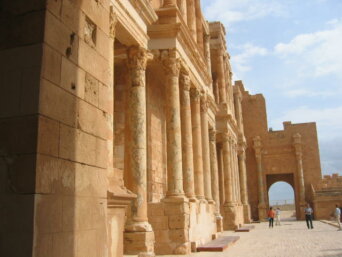- About
- Topics
- Story
- In-Depth
- Picks
- Opinion
- News
- Donate
- Signup for our newsletterOur Editors' Best Picks.Send
Read, Debate: Engage.
| topic: | Conservation |
|---|---|
| located: | Nigeria, Mali, Libya |
| editor: | Bob Koigi |
From the Sabratha Roman city situated at the Libyan coast, the Belize Barrier Reef in the Atlantic to the historic Guinean coastal forests, global iconic heritage treasures are facing imminent danger from climate change as forests disappear and centuries-old buildings get swallowed by rising seas taking with them vital history and connections that have defined mankind and his relationship with nature for generations.
Scientists are sounding the alarm over the rate at which vagaries of the weather have had a toll on natural world heritage. International Union for Conservation of Nature, IUCN, a body involved in the conservation of nature, in a 2017 report indicated that climate change remained the greatest threat to global heritage sites with that threat having nearly doubled in three years. The impact of weather changes on world heritage sites was evident in 62 sites in 2017 from 35 in 2014, the conservation body noted.
Researchers further posit that crucial towns in Zanzibar, Comoros, Gambia, Nigeria, Tunisia and Togo stare at serious risk by 2050 as coastal erosion and warming seas reach unprecedented levels.
While these sites have been a vital aspect of human existence, the growing climate change threat now extends to communities that rely on them. The historic Djenné town in Mali for example, known for its signature earthen buildings and mosques has been hailed for its environmentally friendly architecture that consumes less energy, emits minimum greenhouse gases and remains more resilient to climate change than conventional buildings. But a drop in water at the inland Niger Delta where the communities get the mud for construction as a result of climate change has meant travelling for longer distances in search of the mud. Because it is a costly affair, locals have resulted to cheaper alternatives like clay which are threatening to wipe the much-protected history and heritage of the town.
But it is not all doom and gloom. UNESCO World Heritage and Sustainable Development Policy, that advocates for equality, human rights and long term sustainability in managing heritage sites, was adopted by the World Heritage Convention which has given local communities an upper hand in management and restoration of these treasures. Traditional practices are crucial in saving the sites which is why this is a huge win. What is now required is government and international community support in terms of more legislation, policies and financial investment in research to inform a blended heritage conservation approach.
Image by IXIA
